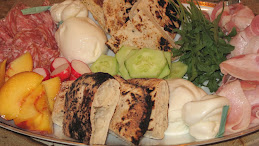The vegetable that everyone loves to use as a fruit, rhubarb is simply wonderful. Special whenever it's about it's a real treasure now during this bleak end of February. Deep into the 'hungry gap' - named for the lack of fresh new produce yet to mature whilst the last of the winter crops and storage of root veg and brassica's is running out - the prospect of another week of turnip mash or leek soup, boiled carrots and roasted beetroots to finish the month is less than delightful. I love these veg - along with parsnips and swede, celeriac and cabbage, mushrooms and kale - but it's been the backbone of the veg bag for months. Into the midst of the gloom early forced rhubarb appears at the market, the slender pink stalks a harbinger of spring and the very definition of joy.
Rhubarb grew first in Asia, the cold climes of Mongolia and Siberia were ideal. It was traded along the Silk Road into China and was taken into Italy sometime around the 16th century, from where it arrived in England in the early 1600's. Initially it was mostly medicinal - some strains are useful in the treatment of lung and liver ailments but it seems the wrong strain was introduced to England so cultivation as a source of drugs failed to thrive. Then in 1817 there happened one of those freak accidents that changed the fortunes of rhubarb completely. A gardener at Chelsea Physic Garden unwittingly covered the rhubarb in soil during the winter and later, when the dirt was cleared, rather than finding all the plants to be dead there were tender shoots that were far superior in flavour to the outdoor variety. So the idea of 'forcing' was born. Commercial growers in London began deliberately covering the plants with soil or manure in order to produce the blanched stems, some going further by lifting the roots and moving them inside heated sheds to simulate the arrival of spring.
In the 1870's forced rhubarb began to be grown in Yorkshire - the area now so famous for it that in 2010 it was awarded the Protected Designation of Origin by the European Commission. In perhaps the second lucky accident for forcing, the frost pocket holding Leeds, Wakefield and Morley combined with local conditions proved to be ideal. Sheds were specially constructed for the first time, the local heavy clay soil was particularly well suited, cheap coal from the local mines made heating the forcing sheds viable, there was plenty of horse manure and 'shoddy' - a by product of the local wool industry - was a perfect mulch for the young crowns. Warmth and moisture tricked the young plants into thinking it's spring, and so it grew its lovely bright pink stems; apparently you can hear the rhubarb crackle as it grows, something I would love to witness. Picking was done by hand in candlelight, pretty much the method still used today.
So much rhubarb was produced each day and sent to market that the Great Northern Railway Company ran a special train - the Rhubarb Special! It ran nightly from just before Christmas till Easter to transport the crop to London Spitalfields and Covent Garden Markets, at its peak taking 200 tonnes of rhubarb a day. Imagine that.
It's a much smaller industry now but the forced rhubarb grown in Yorkshire is still very special indeed, its elegant sourness a lovely match for the delicate pink of the stalks. The care that goes into its production is well rewarded by showcasing the stalks. Rather than simply stewing them down to make crumble - my favourite way of using the later outdoor varieties - I really wanted to make cake. This recipe comes slightly adapted from Band of Bakers. The rhubarb is a perfect match with stem ginger, for both its sweetness and the tiny prickle of heat.
Rhubarb and Ginger Cake
You really need to use forced rhubarb for this cake, as the outdoor grown stuff would be too bitter
140g unsalted butter
200g soft light brown sugar
200g wholegrain spelt flour
2 teaspoons baking powder
2 eggs, whisked in a small bowl
5 pieces stem ginger in syrup, chopped fine, plus 2 tablespoons of syrup from the jar
Rhubarb stems, bright as you like, cut into 19cm lengths to fit the cake tin
Caster sugar for dredging
Preheat the oven to 180 C/350 F/gas 4. Grease and line a 20cm square cake tin, I used a loose bottomed one for ease of turning out.
Melt the butter in a large saucepan over a medium heat, then stir in the brown sugar till fully combined, this takes a few minutes until the sugar melts properly into the hot butter. Leave to cool for a few minutes.
Sift the flour and baking powder together and stir into the butter and sugar mixture, along with the eggs and chopped ginger, until well combined. Scrape the batter into the prepared cake tin and level it off with the edge of spatula.
Lay the rhubarb stems onto the top of the cake - try to squeeze in as many as possible as they shrink a bit during baking. Bake in the centre of the oven for around 45 minutes until the cake has risen and a skewer inserted into the middle of the cake comes out clean.
As soon as the cake comes out of the oven brush the top with generous amounts of ginger syrup from the stem ginger jar and dredge with caster sugar. Leave the cake to cool in the tin for about 20 minutes then turn it out onto a wire rack, rhubarb side up.
Serve warm with thick cream or ice cream as a dessert or else cold, sliced generously for afternoon tea.
Guaranteed to brighten your week.





No comments:
Post a Comment